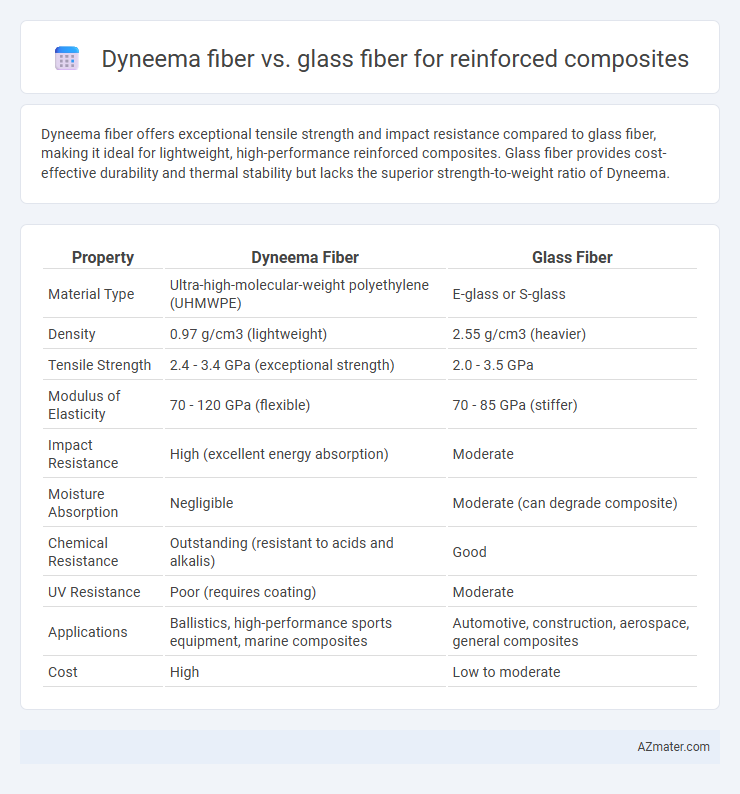Dyneema fiber offers exceptional tensile strength and impact resistance compared to glass fiber, making it ideal for lightweight, high-performance reinforced composites. Glass fiber provides cost-effective durability and thermal stability but lacks the superior strength-to-weight ratio of Dyneema.
Table of Comparison
| Property | Dyneema Fiber | Glass Fiber |
|---|---|---|
| Material Type | Ultra-high-molecular-weight polyethylene (UHMWPE) | E-glass or S-glass |
| Density | 0.97 g/cm3 (lightweight) | 2.55 g/cm3 (heavier) |
| Tensile Strength | 2.4 - 3.4 GPa (exceptional strength) | 2.0 - 3.5 GPa |
| Modulus of Elasticity | 70 - 120 GPa (flexible) | 70 - 85 GPa (stiffer) |
| Impact Resistance | High (excellent energy absorption) | Moderate |
| Moisture Absorption | Negligible | Moderate (can degrade composite) |
| Chemical Resistance | Outstanding (resistant to acids and alkalis) | Good |
| UV Resistance | Poor (requires coating) | Moderate |
| Applications | Ballistics, high-performance sports equipment, marine composites | Automotive, construction, aerospace, general composites |
| Cost | High | Low to moderate |
Introduction to Reinforced Composites
Reinforced composites combine a polymer matrix with high-strength fibers like Dyneema and glass to enhance mechanical properties such as tensile strength and impact resistance. Dyneema fiber, known for its ultra-high molecular weight polyethylene structure, offers exceptional toughness and lower weight compared to traditional glass fiber, making it ideal for lightweight, high-performance applications. Glass fiber remains widely used due to its affordability, stiffness, and thermal stability, but Dyneema's superior energy absorption and durability make it increasingly popular in advanced composite materials.
Overview of Dyneema Fiber
Dyneema fiber, known as ultra-high-molecular-weight polyethylene (UHMWPE), boasts exceptional tensile strength and lightweight properties compared to traditional glass fiber used in reinforced composites. Its high energy absorption and impact resistance make it ideal for applications requiring superior durability and flexibility, such as ballistic protection and marine structures. Unlike glass fiber, Dyneema offers enhanced fatigue resistance and corrosion stability, resulting in longer service life and improved performance in harsh environments.
Overview of Glass Fiber
Glass fiber, widely used in reinforced composites, offers excellent tensile strength, chemical resistance, and thermal stability, making it suitable for a variety of industrial applications. It features a lower cost compared to Dyneema fiber but has a higher density and lower impact resistance. Glass fiber composites are favored in automotive, marine, and construction industries due to their durability and cost-effectiveness.
Mechanical Properties Comparison
Dyneema fiber exhibits superior tensile strength and impact resistance compared to glass fiber, making it ideal for lightweight reinforced composite applications requiring high durability. Glass fiber offers higher stiffness and better compressive strength, suitable for structural components where rigidity is critical. The choice between Dyneema and glass fiber depends on balancing flexibility, strength-to-weight ratio, and specific mechanical performance demands in composite design.
Weight and Density Analysis
Dyneema fiber exhibits a significantly lower density of approximately 0.97 g/cm3 compared to glass fiber's density of about 2.5 g/cm3, resulting in much lighter reinforced composites. This weight advantage enhances applications requiring high strength-to-weight ratios, such as aerospace and sporting goods. Despite similar tensile strengths, Dyneema-reinforced composites provide superior weight savings and improved impact resistance over glass fiber counterparts.
Impact Resistance and Durability
Dyneema fiber, known for its ultra-high molecular weight polyethylene composition, exhibits exceptional impact resistance in reinforced composites, outperforming glass fiber by absorbing and dissipating energy more effectively. While glass fiber offers good rigidity and moderate impact resistance, it is more prone to brittle failure under high-stress impacts compared to the flexible and tough nature of Dyneema fiber. Regarding durability, Dyneema fiber composites resist fatigue and environmental degradation better due to superior chemical resistance and moisture stability, making them ideal for long-lasting, high-performance applications.
Flexibility and Malleability
Dyneema fiber offers superior flexibility and malleability compared to glass fiber, making it ideal for applications requiring lightweight yet highly deformable reinforced composites. Glass fiber, while strong and rigid, tends to be brittle and less adaptable to complex shapes due to its limited flexibility. The enhanced molecular structure of Dyneema provides improved elongation and bending capabilities, significantly outperforming glass fiber in dynamic and impact-resistant composite materials.
Cost and Manufacturing Considerations
Dyneema fiber offers superior strength-to-weight ratio and impact resistance compared to glass fiber, but its higher raw material cost significantly affects overall composite manufacturing expenses. Glass fiber remains more cost-effective and widely available, enabling large-scale production with established processing techniques, which reduces labor and equipment costs. Manufacturing composites with Dyneema requires advanced handling due to its sensitivity to heat and UV exposure, while glass fiber composites benefit from more robust, versatile manufacturing processes.
Typical Applications in Industry
Dyneema fiber offers superior impact resistance and lightweight properties, making it ideal for ballistic armor, aerospace components, and high-performance sporting goods. Glass fiber, known for its excellent tensile strength and cost-effectiveness, is predominantly used in automotive parts, construction materials, and marine applications. The choice between Dyneema and glass fibers depends on specific industry requirements for strength, weight, and durability.
Conclusion: Choosing the Right Fiber
Dyneema fiber offers superior tensile strength-to-weight ratio and excellent impact resistance compared to glass fiber, making it ideal for high-performance, lightweight composite applications. Glass fiber provides cost-effective durability and higher stiffness, suitable for structural uses where budget and rigidity are prioritized. Selecting the right fiber depends on balancing performance requirements, weight constraints, and budget considerations in reinforced composite design.

Infographic: Dyneema fiber vs Glass fiber for Reinforced composite
 azmater.com
azmater.com